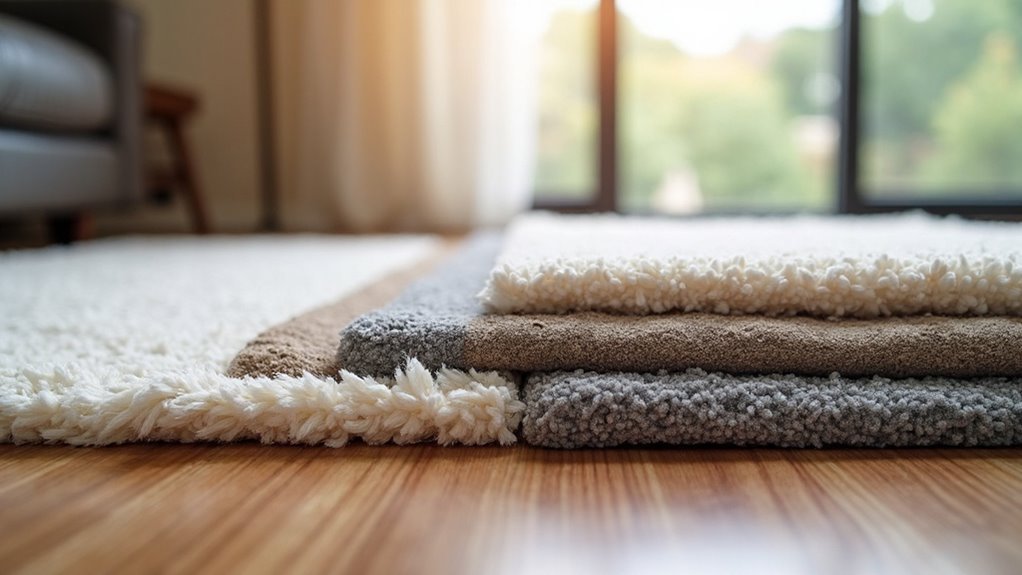When you’re planning to install new carpeting, you might overlook the vital layer beneath: the underlay. It’s more than just padding—it’s the foundation that determines your floor’s comfort, durability, and performance. If you’ve ever wondered why some carpets feel luxurious while others seem flat and lifeless, the secret lies in selecting the right underlay. What makes one type superior to another, and how can you guarantee you’re making a smart choice? Stay tuned to uncover the hidden world of carpet foundations.
Understanding Different Carpet Underlay Materials
While many homeowners overlook carpet underlay, selecting the right material can greatly impact your floor’s comfort, durability, and performance.
Foam underlay offers lightweight cushioning and comes in various densities, from soft PU foam to denser rubber-based options.
Felt underlay provides excellent sound absorption and creates a smooth surface underneath carpets.
Rubber underlays deliver superior durability and are ideal for high-traffic areas, offering exceptional resilience against compression.
Natural hair underlays, like wool, provide exceptional insulation and moisture regulation.
Synthetic options like polypropylene deliver cost-effective protection with moderate cushioning.
Your choice depends on several factors: room usage, budget, carpet type, and desired performance characteristics.
Dense underlays work best in living rooms and hallways, while softer materials suit bedrooms.
Understanding these materials helps you make an informed decision that enhances your carpet’s comfort and longevity.
Key Performance Characteristics of Quality Underlay
Quality carpet underlay isn’t just about adding softness; it’s a vital component that determines your floor’s long-term performance and comfort.
When selecting underlay, you’ll want to take into account key performance characteristics that impact durability, sound absorption, and thermal insulation.
Thickness matters greatly. Thicker underlays provide better cushioning, reducing wear on your carpet and creating a more comfortable walking surface.
Density is equally important, as higher-density materials offer superior support and longevity.
Thermal resistance helps regulate room temperature, potentially lowering heating costs.
Sound-dampening properties can minimize noise transmission between floors, creating a quieter living environment.
Additionally, moisture-resistant underlays prevent mold growth and protect your flooring investment.
Choosing the Right Underlay for Specific Room Types
Different rooms demand specific underlay characteristics to optimize performance and comfort.
In high-traffic areas like hallways and living rooms, you’ll want dense, durable underlays that can withstand constant foot traffic and provide superior sound absorption.
Bedrooms benefit from softer, more cushioned underlays that enhance comfort and reduce noise transmission between floors.
For moisture-prone spaces like basements or bathrooms, choose waterproof or moisture-resistant underlays to prevent mold and mildew growth.
Home offices require underlays with excellent noise reduction properties to minimize sound distractions during work hours.
Thick, resilient underlays work best in children’s rooms, offering extra cushioning for play areas and reducing impact noise.
Installation Tips and Best Practices
Although proper carpet underlay selection is vital, correct installation plays an equally important role in maximizing its performance and longevity.
You’ll want to verify a clean, dry, and smooth subfloor before laying the underlay. Remove any debris, repair uneven surfaces, and address moisture issues to prevent future problems.
When installing, overlap the underlay seams slightly and secure them with specialized tape. Trim excess material carefully around edges and corners, guaranteeing a precise fit.
Don’t stretch the underlay too tightly; it should lay flat without wrinkles or bubbles.
Pay attention to manufacturer guidelines for specific installation requirements. Some underlays need acclimation time before installation, while others have unique fastening methods.
Taking time to install correctly will greatly improve your carpet’s comfort, durability, and overall performance.
Cost and Long-Term Value Considerations
When investing in carpet underlay, you’ll find that upfront costs don’t tell the whole story. While premium underlays might seem expensive initially, they’ll save you money in the long run by extending your carpet’s lifespan and improving energy efficiency.
Cheaper options like basic foam might cost less at purchase, but they’ll compress quickly and require earlier replacement. High-quality materials like rubber or felt provide better durability and performance, reducing long-term expenses.
You’ll also benefit from enhanced sound insulation, improved comfort, and better thermal regulation.
Consider your specific needs and budget. Investing in a quality underlay isn’t just an expense—it’s a smart home improvement strategy that protects your flooring and increases overall comfort. The right choice can deliver significant value over time.
Conclusion
When you’re ready to upgrade your flooring, choosing the right carpet underlay can change your home’s comfort and durability. Don’t just settle for any material—consider your specific needs, room usage, and budget. By understanding the unique benefits of different underlays, you’ll make a smart investment that enhances your living space and provides long-lasting performance. Your floors will thank you.
